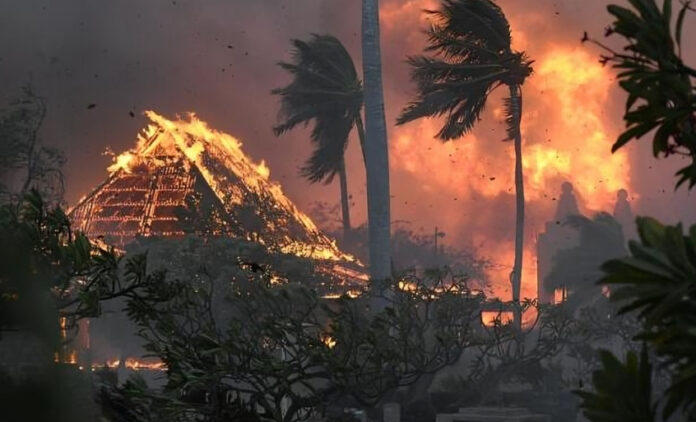The idyllic Hawaiian paradise of Maui was transformed into an apocalyptic nightmare in August 2023 as raging wildfires swept through the island, leaving a trail of unfathomable destruction in their wake. The historic inferno, now etched into history as the deadliest wildfire disaster on U.S. soil in modern times, claimed over 100 precious lives and laid waste to the once vibrant town of Lahaina, reducing it to smoldering ruins.
As the smoke begins to dissipate and the heartbroken island community attempts to piece together the tattered remains of their lives, a pair of harrowing reports have exposed a perfect storm of compounding factors that precipitated this unimaginable tragedy. The findings lay bare a tapestry of failures, miscalculations, and harsh realities that Maui was tragically unprepared to confront.
The Maui Fire Department’s Damning Self-Assessment
In an act of remarkable transparency and accountability, the Maui Fire Department commissioned an exhaustive 84-page report from the Western Fire Chiefs Association, unflinchingly examining the myriad shortcomings that hamstrung the island’s ability to mount an effective response to the wildfires. The report, a brutally honest dissection of the department’s preparedness, pulled no punches in identifying over 100 recommendations across 17 distinct “challenge” areas.
From a distinct lack of comprehensive disaster planning and preparedness protocols to a severe shortage of essential rescue personnel, equipment, and resources, the report painted a grim portrait of an agency ill-equipped to confront a crisis of such epic, unprecedented proportions. Perhaps most damning of all was the revelation that despite dire red flag warnings from the National Weather Service days in advance, explicitly cautioning of potential wildfire conditions, the fire department failed to adopt a “heightened sense of urgency.”
This critical lapse in situational awareness proved catastrophic, as the department found itself caught flat-footed and woefully underprepared when the wildfires rapidly intensified, transforming from a seemingly routine brush fire into an unholy inferno fueled by winds gusting up to 80 mph.
“While I’m incredibly proud of our department’s response, I believe we can always improve our efforts,” Maui County Fire Chief Brad Ventura conceded in a sobering press conference, his candid admission underscoring the grave shortcomings exposed and the department’s steadfast commitment to learning from this unimaginable tragedy.
A Searing Firsthand Account of Sheer Chaos and Desperation
While the Fire Chiefs Association’s report focused on identifying systemic failures and proposing corrective measures, a separate 376-page investigation from the esteemed Fire Safety Research Institute offered an unflinching, moment-by-moment account of the wildfires’ relentless advance and the sheer desperation that ensued.
Commissioned by Hawaii Attorney General Anne Lopez, this report serves as the first phase of a comprehensive three-part probe into the state and local governments’ response to the crisis. With vivid, harrowing details and a meticulous timeline spanning over 12,000 entries from August 8th to 10th, the report transports readers into the heart of the inferno, bearing witness to the surreal scenes that unfolded.
Firefighters and police officers recount tales that defy comprehension – metal rooftops taking flight like deadly frisbees, crashing down on vehicles, and heroic rescues from buildings engulfed in flames. The report traces the origin of one of the fires to the morning hours of August 8th, when a swiftly moving brush fire ignited near Lahaina Intermediate School, only to reignite with terrifying ferocity less than an hour after firefighters believed they had extinguished it.
Whipped into an insatiable frenzy by hurricane-force winds, the resurgent blaze ignited nearby grasslands and began its inexorable march, propelled by a perfect storm of direct flames, searing radiant heat, and a torrent of airborne embers raining down like hellfire. Within a matter of hours, multiple structures were ablaze, and a desperate battle to evacuate residents and contain the escalating inferno was underway – a battle that would ultimately prove futile in the face of such overwhelming forces of nature.
A Catastrophic Failure of Communication
While the extreme weather conditions and rapid escalation of the wildfires undoubtedly posed formidable challenges, one factor that proved particularly crippling was the catastrophic breakdown of communication systems across the island. As the fires raged with unprecedented ferocity, cell phone and internet services became increasingly sporadic and unreliable, leaving residents and emergency responders alike scrambling for crucial updates, information, and evacuation notices.
According to Hawaii State Representative Elle Cochran, whose district encompasses the devastated town of Lahaina, the communication failures were unequivocally “the biggest issue” that exacerbated the crisis. “The number one biggest thing is communication. I mean, that is when everything fell apart,” Cochran lamented in an interview with USA Today. “We had no communication, and we were all left in the dark. It happened for days, even after the incident.”
The Fire Chiefs Association’s report echoed these sobering observations, underscoring the urgent need for a comprehensive overhaul and analysis of the island’s cellular infrastructure. Additionally, the report advocated for the implementation of a new, multilingual evacuation plan tailored to Maui’s diverse communities – a glaring oversight that left many residents, particularly those with limited English proficiency, stranded and perilously uninformed as the inferno closed in.
Cochran recounted the monumental challenges she personally faced in her frantic efforts to secure translators for Lahaina’s sizable Filipino population, many of whom are native Ilocano speakers. “I had a hub where I had FEMA there seven days a week trying to help the community. But 40% of the population in Lahaina is Filipino. In particular, there were Ilocano (an Austronesian language spoken in the Philippines) speakers, and we didn’t have any people ready to translate it that way,” she explained. “And I kept asking every day, ‘Translator, we need a translator,’ and it never happened.”
A Solemn Vow: Building Resilience from the Ashes
While the two reports offer an unflinching indictment of the multitudinous failures that paved the way for the Maui wildfires to engulf the island in unimaginable tragedy, they simultaneously provide a critical blueprint for ensuring such a catastrophe never happens again. As Hawaii Attorney General Anne Lopez solemnly affirmed, “Responsible governance requires we look at what happened, and using an objective, science-based approach, identify how state and county governments responded.”
The Fire Safety Research Institute’s report resoundingly echoed this sentiment, declaring that the paramount focus must now shift to “strengthening emergency response capabilities and building more resilient communities that can withstand the increasing challenges posed by a changing climate and the ever-present threat of wildfires.”
For Representative Cochran, the path forward is crystal clear, forged from the searing lessons etched into the collective psyche of Maui’s residents: “Who could’ve predicted that something that strong and that fierce could occur in collaboration with the fire? Next time, there are going to have evacuation routes, we’re going to have connectivity and communication, and we’re going to have enough fire trucks.”
As the people of Maui begin the arduous process of mourning their unfathomable losses and reconstructing their shattered lives from the ashes, the findings of these reports must serve as an unwavering catalyst for transformative change. By confronting the harsh realities exposed by the wildfires, addressing the systemic shortcomings and resource deficiencies that left the island perilously vulnerable, and fostering a resilient, well-prepared community, Maui – and Hawaii as a whole – can fortify itself against the ever-increasing threats posed by an increasingly unpredictable climate and the ever-looming specter of wildfires.
For now, a solemn pall hangs over the island as Maui mourns the staggering toll of lives lost and dreams incinerated by the unrelenting inferno. Yet from this crucible of unspeakable tragedy emerges an indomitable spirit of resilience, a steely determination to honor the fallen by rising from the ashes, fortified and emboldened to face the challenges that lie ahead, so that never again will such a cataclysm befall this island paradise.























